Stonly for Digital Adoption: Features, Pricing, and Review
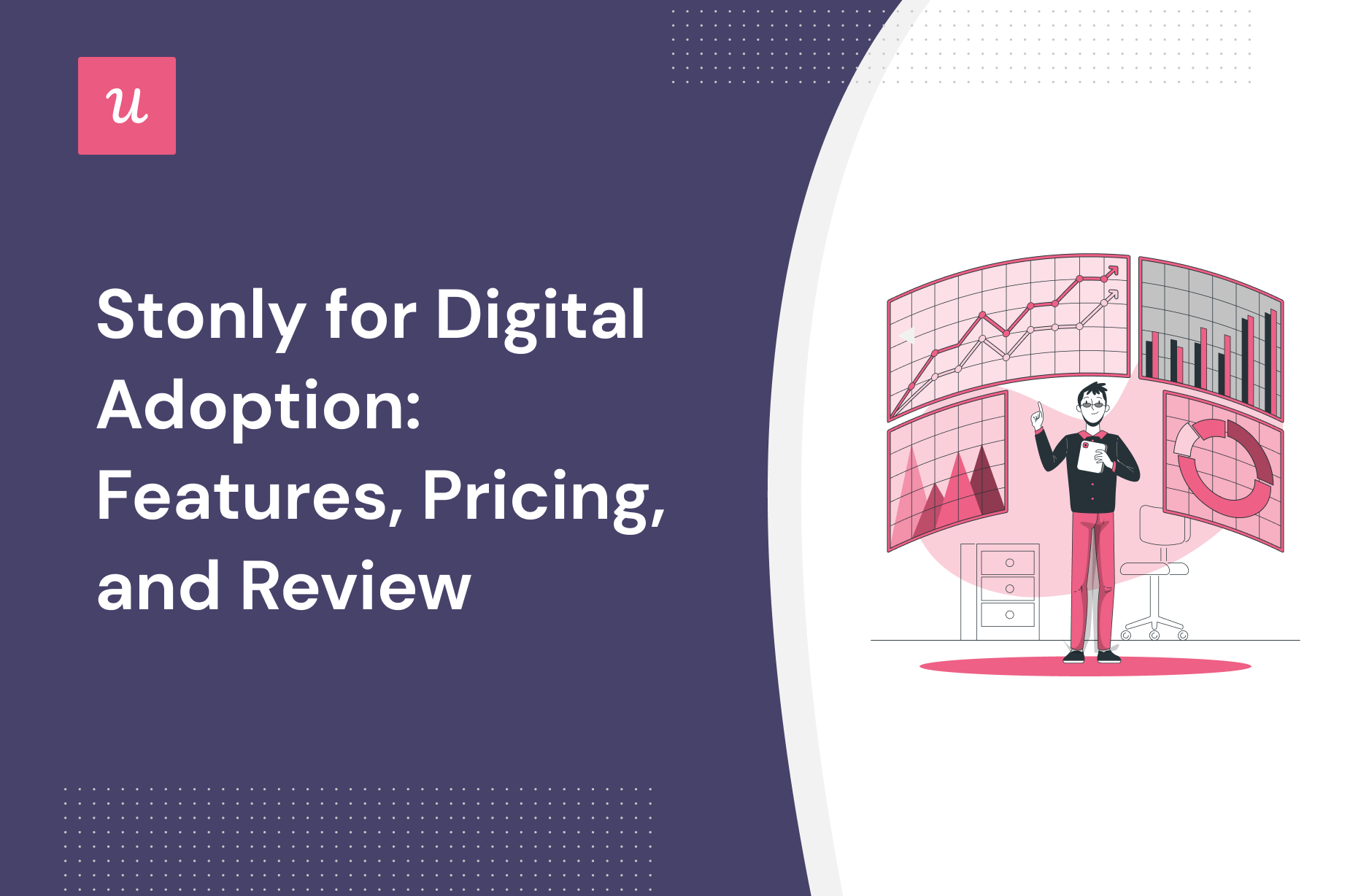
Looking for an effective Digital adoption tool and wondering if Stonly is the best option for your SaaS company?
With numerous Stonly alternatives, it can be challenging to make a final decision.
In this article, we’ll delve into precisely that – helping you determine whether Stonly is the ideal choice for your Digital adoption needs. We’ll explore its features, pricing, and offer a comprehensive review to aid in your decision-making process.
Let’s get started!
TL;DR
- Stonly is a good choice for Digital adoption and it comes with features such as tooltips, feature tags, interactive walkthroughs, and in-app announcements.
- There are a few clear scenarios where Stonly wouldn’t be the best solution to use. If you’re in any of these scenarios then considering an alternative platform would probably be best:
- Feature Mismatch: If user onboarding or product adoption are your main goals, then Stonly’s feature set may not align with that use case. Its ability to build in-app guides or survey customers is limited by the platform’s coding requirements and pricing structure.
- Budgetary Constraints: Companies who are operating on a tight budget should steer clear of Stonly due to the extra charges that occur if your guides get more than 4,000 views per month. If guide views reach 30,000 then you’ll be paying an additional $500 on your plan each month.
- Existing Knowledge Bases: Building knowledge bases is the primary use case for Stonly’s feature set. If you already have an existing knowledge base, then you’d be better off with an alternative like Userflow that integrates with Freshdesk, HubSpot, and Zendesk knowledge bases.
- If you’re looking for a better option for Digital adoption, Userpilot exceeds both functionality and value for money compared to Stonly. Ready to see Userpilot in action? Schedule a demo today to explore its powerful Digital adoption capabilities firsthand.
![]()
Looking for A Better Alternative for Digital Adoption? Try Userpilot

What is Stonly?
Stonly positions itself as a cheaper alternative to some of the pricier product adoption solutions on the market. In reality, it’s more of a customer service tool that can be used to build knowledge bases rather than an actual onboarding or adoption platform.
As a result, the tour builder on Stonly feels more like an add-on to its knowledge base functionality rather than a product of its own.
This also means that its in-app engagement features will be rather limited (especially in the no-code regard) compared to alternatives like Userpilot or Appcues.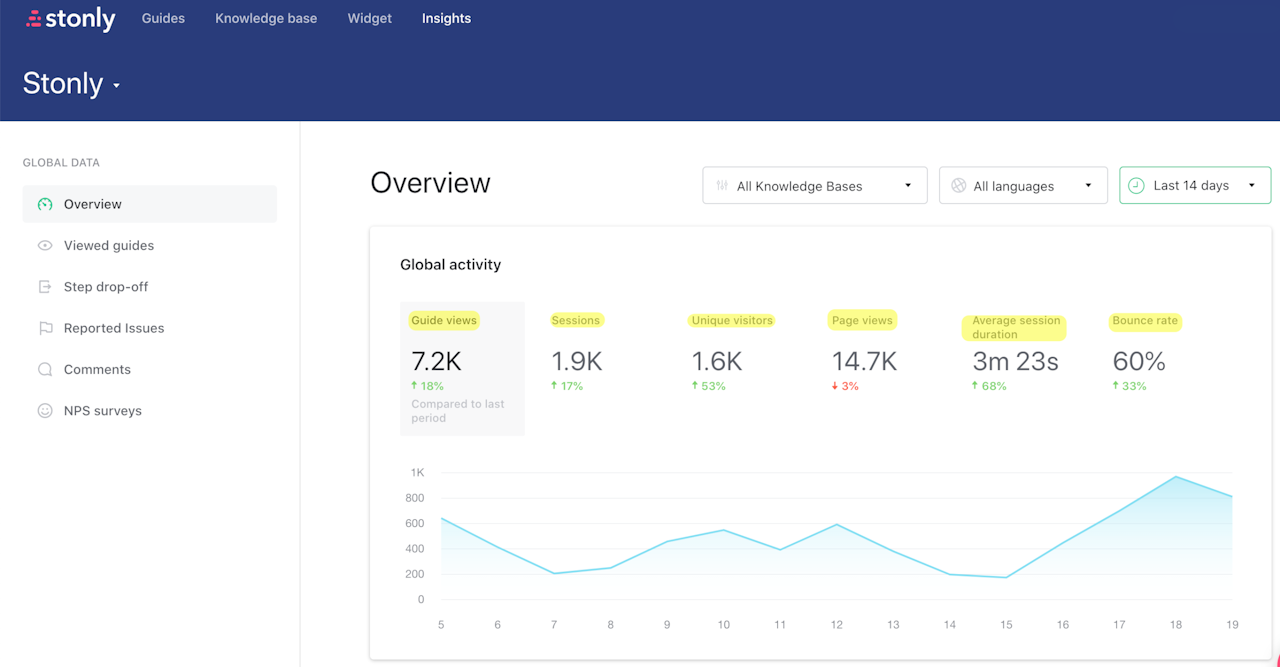
Must have features of digital adoption tools
An efficiently designed digital adoption platform guides users through complex apps with ease. Here are some features that DAPs must have:
- In-app learning: With efficient DAPs, users receive timely in-app guidance through interactive walkthroughs, product tours, and contextual UI patterns (tooltips, modals, etc.) to achieve their goals.
- User segmentation: Segmenting users by shared needs, jobs to be done, demographics, etc., helps tailor their product journey. This is crucial for keeping users adopted and retained.
- In-app self-help: Users want quick and easy support, so the DAP you select must be able to create and customize an in-app self-service widget with a knowledge base, video tutorials, etc.
- Product analytics: Analyzing product usage and user actions is crucial to assess the success of your adoption strategies.
- Microsurveys: Look for a platform that lets you design different types of surveys, trigger them contextually, and gather feedback effortlessly.
- Integrations: A DAP should integrate easily with your existing tech stack, whether cloud-based or on-premise, ensuring seamless operations and maximizing utility.
Stonly features for digital adoption
Feature adoption is paramount for product stickiness. While Stonly has features like in-app guides and knowledge bases that can drive feature adoption, UI triggers are best at driving adoption for individual features. Here’s an overview of Stonly’s UI trigger types, requirements, and limitations:
- Types: Stonly has different types of UI triggers such as pills that appear at the bottom of the screen, banners that show up at the top, and hotspots or icons that appear next to elements. You can also set up hidden triggers that launch a guide when certain conditions are met.

- Limitations: In addition to certain trigger features requiring coding knowledge, they’re also limited by Stonly’s pricing model. Users on the Basic version of Stonly will need to upgrade to the Small Business plan to use UI triggers (which starts at $249/month).
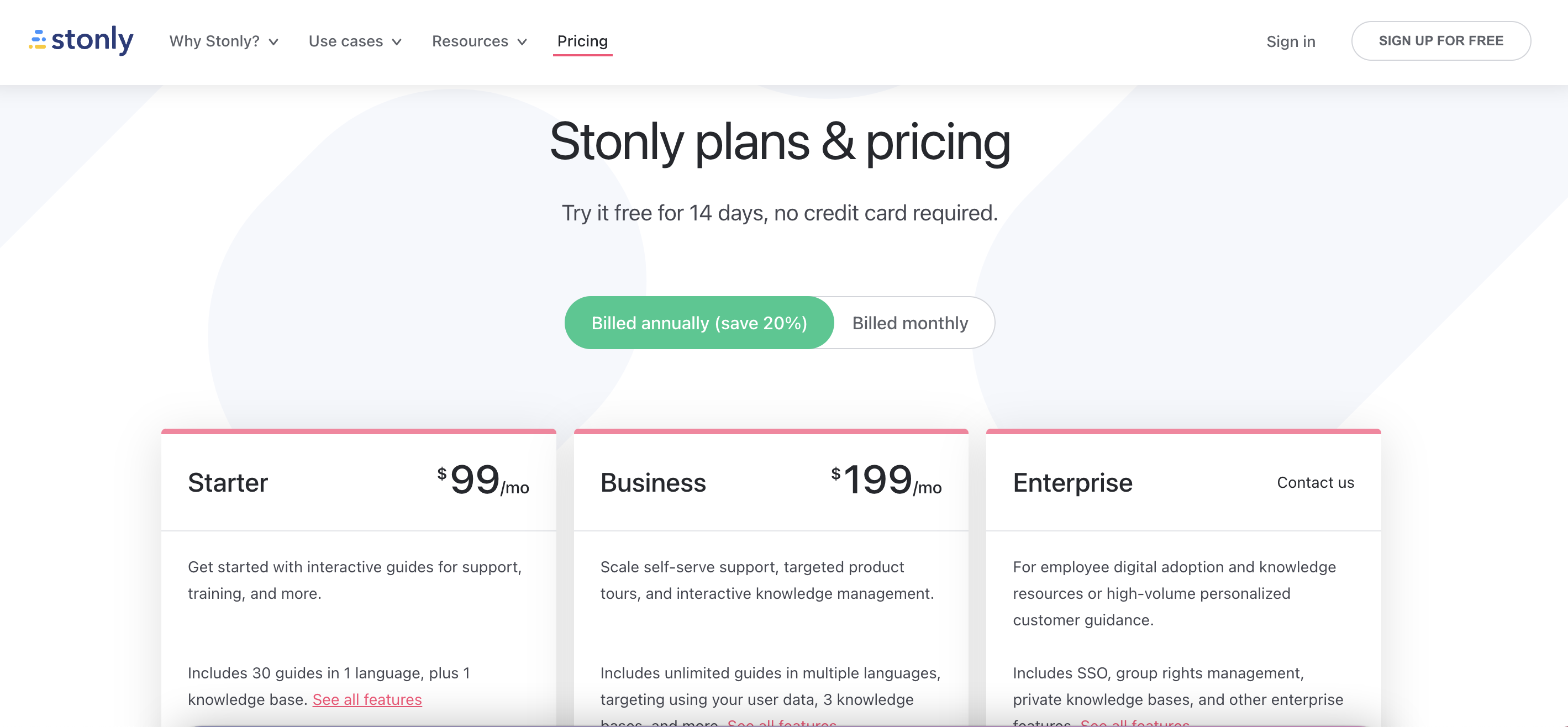
Stonly’s tooltips
Stonly lacks traditional tooltips that expand when users hover over an element but it does have information icons that can trigger guides:
Here’s how you can use Stonly to trigger contextual guides that work as onboarding tooltips:
- Icons: Icons are one of the UI triggers that you can add with Stonly. You can then launch a guide, tour, or knowledge base module when users click on the information icon next to an element or feature.

- Triggers: Because icons are a type of UI trigger, you’ll be able to apply Stonly’s targeting settings to them. These include URL rules for which pages the icon should be enabled on, targeting conditions based on user properties, and customized designs.
Note: UI triggers are only available on Stonly’s paid plans so users on the Basic version of the platform won’t be able to use them.
- Limitations: Unfortunately, Stonly doesn’t support native tooltips that expand when users hover over an element. Furthermore, failing to tag a UI element properly and set the necessary URL rules could lead to your tooltip triggers being deactivated entirely.
Note: Alternative adoption solutions like Userpilot and Appcues support hover tooltips.
Stonly’s feature tags
Stonly has no native feature tagging capabilities.
However, you could attach UI triggers such as icons to specific elements, set them to trigger a guide, and then see how many unique views that guide gets to guesstimate feature usage.![]()
Note: While this workaround is technically possible, it takes much longer to set up and can only provide vague measures of which feature usage. UI triggers aren’t even available on Stonly’s Basic plan so we’d recommend alternative solutions like Userpilot or Pendo that support feature tagging.
Stonly’s interactive walkthroughs
Interactive walkthroughs are better than linear product tours because they help users learn by doing. Stonly’s knowledge base capabilities may be more fleshed out than its onboarding functionality, but it does have a guide builder, UI patterns, and analytics for walkthroughs too.
Here’s how Stonly lets you use interactive walkthroughs to improve onboarding:
- Guide Builder: The Stonly guide editor lets you create guides, add steps, and edit your content without writing a single line of code. You can also add special steps like surveys, checklists, automations, or external integrations for chat apps like Freshchat and Intercom.

- UI Patterns: Stonly lets you trigger specific guides using various UI patterns. These include pill buttons at the bottom corner of the screen, banners on the top, info icons next to elements, and hidden triggers that activate conditionally. You can also edit the design or targeting for triggers.
Note: UI triggers are only available on Stonly’s paid plans so users on the Basic version of the platform won’t be able to use them.
- Analytics Dashboard: In addition to letting you build interactive walkthroughs and trigger them contextually, Stonly also has an Insights dashboard for global analytics. This will help you track the total number of guide views, how many unique visitors saw them, and track top guides.
Stonly’s in-app announcements
In-app announcements — such as new feature announcements or downtime notices — are an important way of broadcasting updates to your user base. Stonly’s features are geared towards knowledge bases but it can be utilized to make announcements (albeit in a limited capacity).
Here’s how Stonly’s in-app messaging features can help you with announcements:
- Banners: Banners are the most straightforward way to make in-app announcements with Stonly. If you’re making feature-specific announcements then you could set URL rules so that the announcement only appears on a particular page or adjust the design to match the UI.

- Triggers: In addition to banners, Stonly has other UI patterns like icons that appear next to elements or guides that show up when users click on a feature. You can use these to announce new changes to existing features that only show up when customers try to interact with them.
Note: UI triggers are only available on Stonly’s paid plans so users on the Basic version of the platform won’t be able to use them.
- Comments: The comments dashboard can help you review feedback that users leave with regard to your in-app announcements. Because Stonly lets you view comments by step, it’s possible to see which message they were responding to when making multiple announcements.
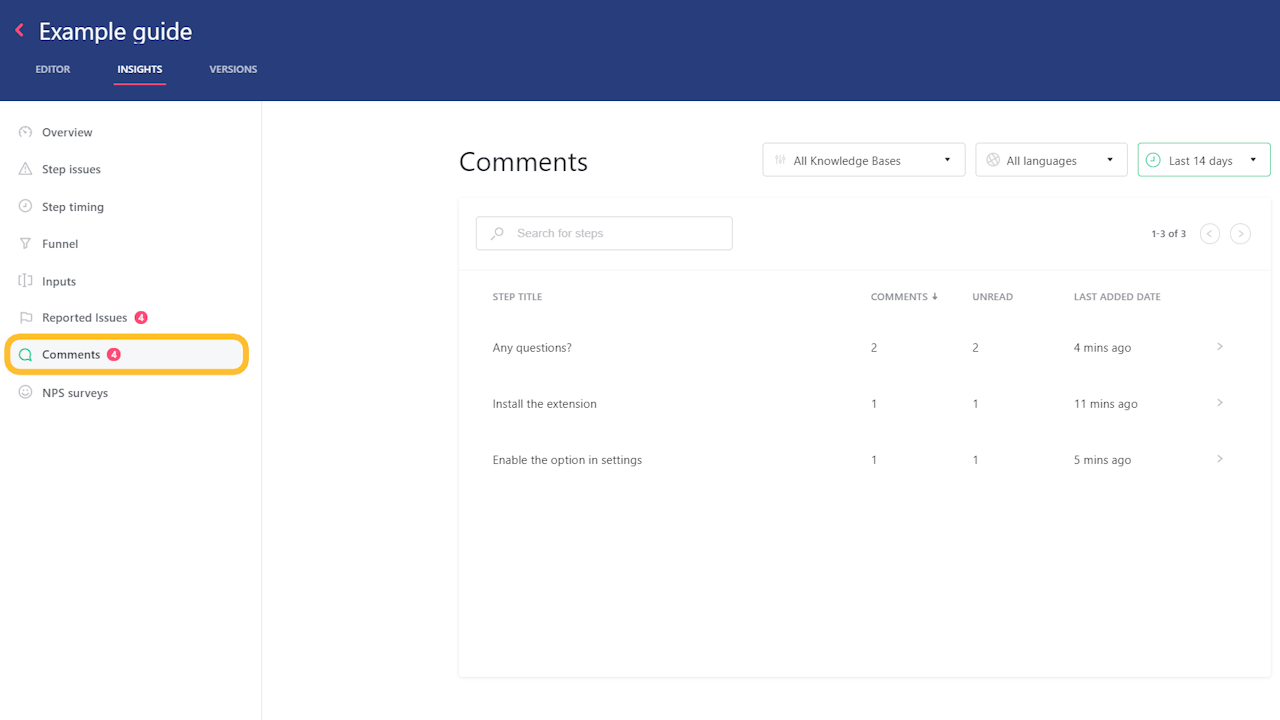
What are the pros and cons of Stonly?
Stonly’s pros
While Stonly isn’t as capable as full-on digital adoption solutions like Userpilot, Pendo, or Appcues, it does have a few benefits:
- Self-Service Support: Because building knowledge bases is the primary use case for Stonly (and arguably its core product), it has advanced self-service support features that could outperform other adoption solutions, such as abundant live chat integrations.
- Analytics Dashboard: Stonly has a unified analytics dashboard that can show you global insights across all your guides. This makes it easier to track content engagement and monitor your key performance indicators (KPIs).
- Guide Builder: While other Stonly features such as event tracking, user targeting, data streaming, and styling require coding, the guide builder uses an intuitively designed visual interface to let you add, edit, or delete steps.
Stonly’s cons
Unfortunately, there are quite a few drawbacks to using Stonly that stem from its lopsided features, no-code capabilities (or lack thereof), and view-based pricing model:
- Feature Set: Seeing as Stonly is a knowledge base builder first and onboarding/adoption solution second, it has quite a few features that are missing, too basic, or difficult to use. If user onboarding and product adoption are your main use cases, consider alternatives.
- Coding Requirements: Unlike most of its competitors, Stonly doesn’t advertise itself as a no-code onboarding/adoption platform. This means you’ll need coding knowledge to track events, target users, stream data, and style your content.
- Pay-as-You-Go Pricing: Stonly’s pricing charges additional fees based on the number of views that guides get. Customers who don’t exceed 4,000 guide views per month won’t be charged extra, but those who do will pay an additional $250 to $500 monthly depending on volume.
What do users say about Stonly?
Despite Stonly’s limitations, there are some aspects of the platform that garner praise from users, such as the ease of publishing:
The ease of creating and embedding a guide in my website. It’s super easy to move from written doc to live guide that is also accessible from my website, which is a live saver.
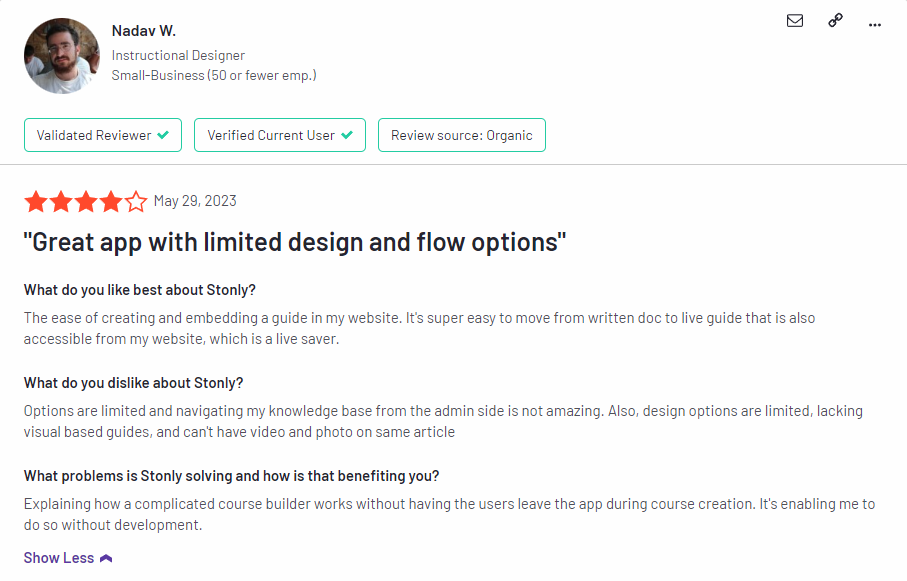 Of course, there are also plenty of criticisms stemming from Stonly being positioned as an interactive guide solution when it’s more of a knowledge base builder:
Of course, there are also plenty of criticisms stemming from Stonly being positioned as an interactive guide solution when it’s more of a knowledge base builder:
“It is very easy to get lost when creating guides and steps in Stonly. because everything is extremely granular and fragmented by design, it is possible to accidentally create the same information in multiple places (instead of ‘linking’ to relevant, already created steps. The real danger here is that should one version of the information be updated, and the other not, you end up with conflicting information in your system, which leads to poor customer experience. It would be nice if there was some way to get a birds-eye view of a knowledge base, including relevant links between steps and guides to minimize this issue.
Another missing element that would be highly desired is a functional “draft/approve” process. We currently use a folder outside of the main KB for new draft articles, however, should one of our lower-level team members be tasked with drafting an update to an existing guide, it is very hard to obtain a clear list of what guides have been edited, where and what has changed, and then as an admin, be able to review, approve and publish. Ideally I would desire some sort of list where the guide edit page is not opened, but rather a list of changes, when you click one you get a pop-up of before/after comparison, and then you can approve and publish without a page load.
The report issues function could do with a link in the resulting email to take you to the edit page for the doc. Currently we need to copy/paste the guide name from the email to the editor portal to find the guide. This has on more than one occasion led to the incorrect guide being edited (sometimes related to the topic in paragraph one of these notes)
When first loading the customer-facing site, the search field shows up, you can start typing, but then the search is cleared and you end up with part of your search term missing and have to start again (minor frustration, however, customers will experience this as a touchpoint of our product, not Stonly, wo it looks bad on our part)
For the tours, you have element selectors for ID and CSS selector. XPATH support would be highly desirable for some of the elements in our app.”
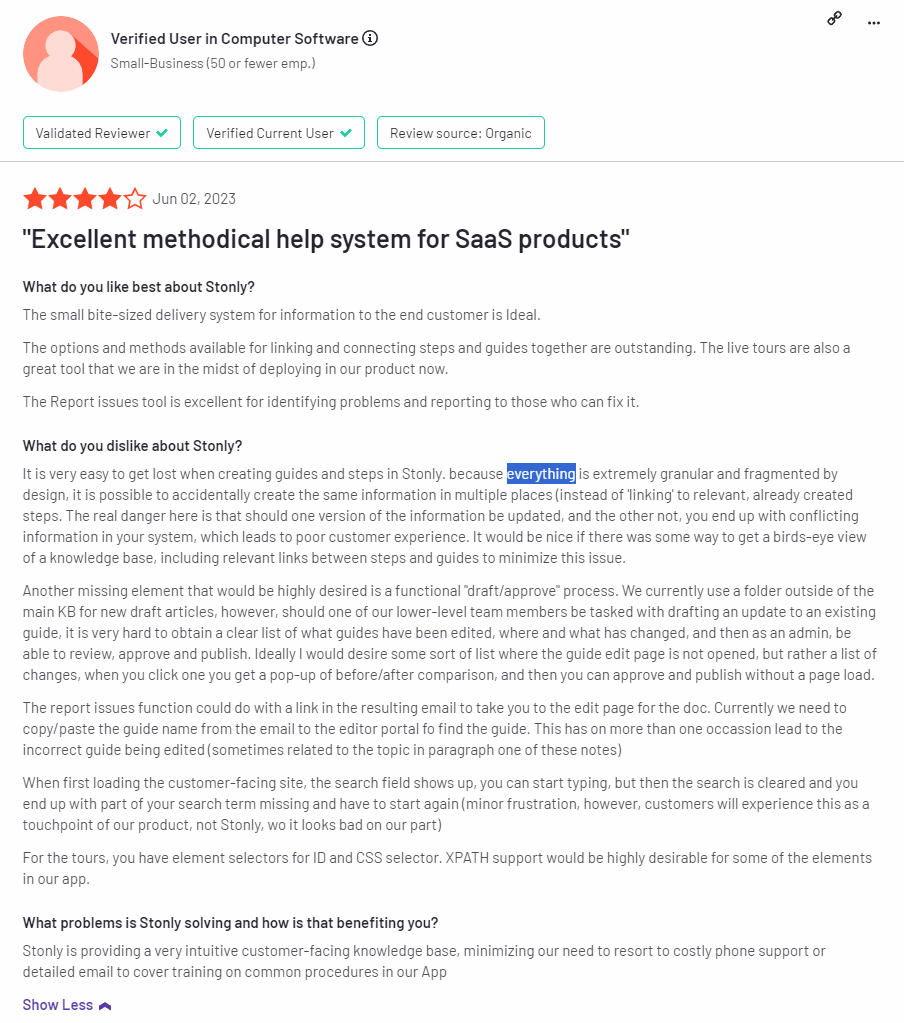
Stonly’s pricing
Stonly offers two paid plans. In addition to the base subscription cost, customers will also be charged additional fees if their guides get more than 4,000 views per month.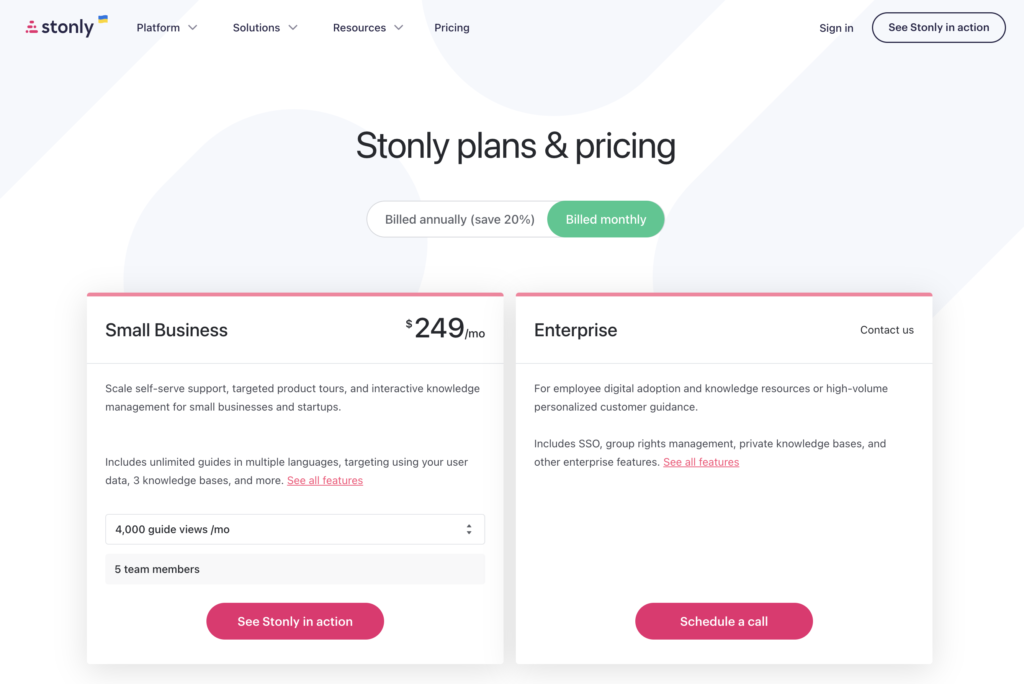
Here’s an overview of Stonly’s two subscription tiers:
- Small Business: Stonly’s Business tier is the entry-level paid plan that starts at $249/month but offers a 20% discount if you bill annually. It includes five team seats, unlimited guides, multi-language support, guide variables, and integrations. You’ll be billed extra if you exceed 4,000 guide views.
- Enterprise: The Enterprise version of Stonly uses quote-based pricing and includes all the features of the Business tier. It has additional features like surveys, automatic guide translation, advanced permissions, additional integrations, priority support, and single sign-on (SSO).
3 Reasons why you might need a Stonly alternative
There are a few clear scenarios where Stonly wouldn’t be the best solution to use. If you’re in any of these scenarios then considering an alternative platform would probably be best:
- Feature Mismatch: If user onboarding or product adoption are your main goals, then Stonly’s feature set may not align with that use case. Its ability to build in-app guides or survey customers is limited by the platform’s coding requirements and pricing structure.
- Budgetary Constraints: Companies who are operating on a tight budget should steer clear of Stonly due to the extra charges that occur if your guides get more than 4,000 views per month. If guide views reach 30,000 then you’ll be paying an additional $500 on your plan each month.
- Existing Knowledge Bases: Building knowledge bases is the primary use case for Stonly’s feature set. If you already have an existing knowledge base, then you’d be better off with an alternative like Userflow that integrates with Freshdesk, HubSpot, and Zendesk knowledge bases.
Userpilot – A better alternative for digital adoption
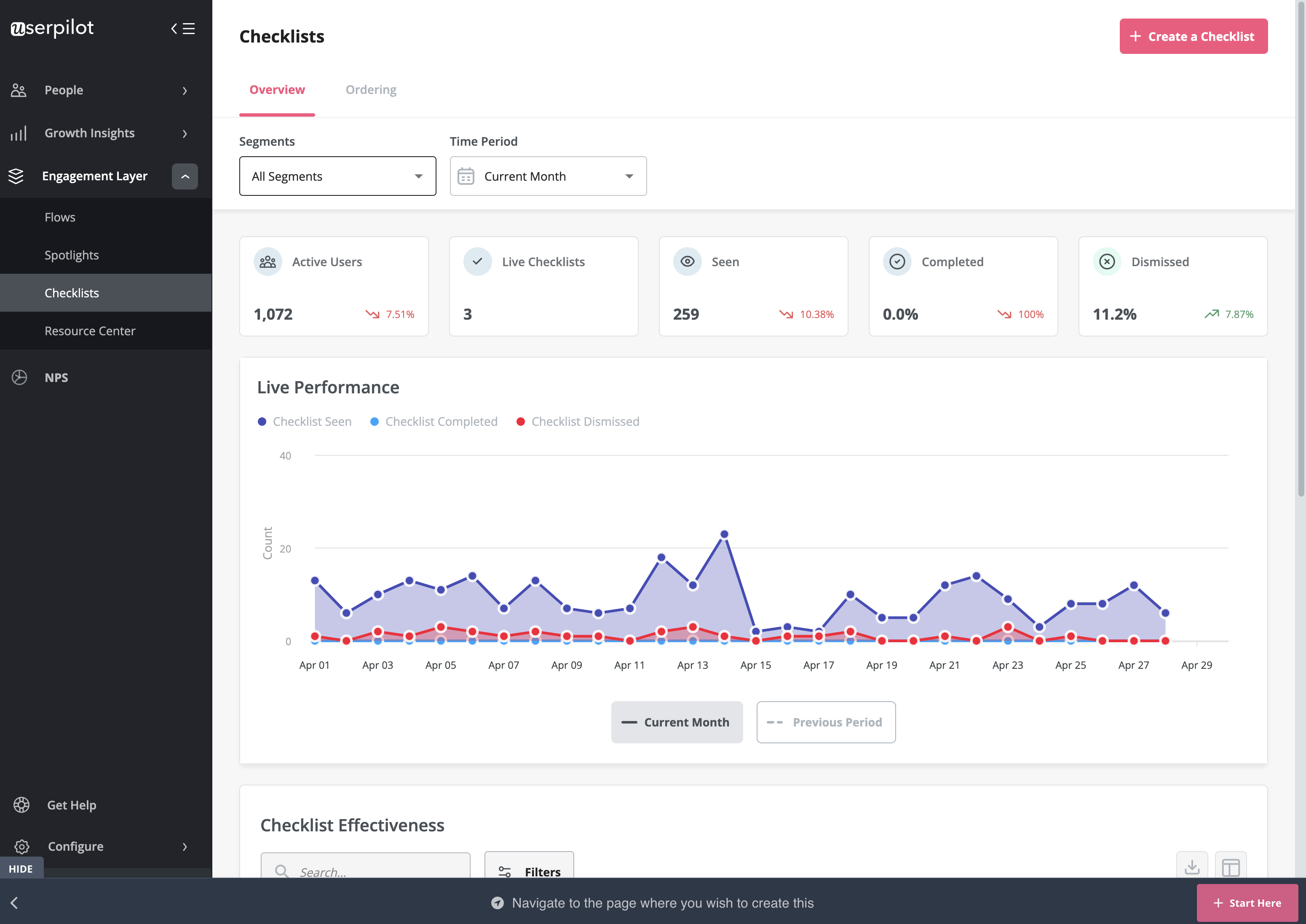 Feature adoption occurs when a user starts using a new/existing feature to solve their problems. Userpilot has built-in capabilities to track feature adoption analytics, identify the most popular features, and leverage UI patterns to help users discover features that they haven’t tried yet.
Feature adoption occurs when a user starts using a new/existing feature to solve their problems. Userpilot has built-in capabilities to track feature adoption analytics, identify the most popular features, and leverage UI patterns to help users discover features that they haven’t tried yet.
- No-code feature tagging: Userpilot’s click-to-track feature tagger lets you tag up to 15 features in the Starter plan and track its interactions without writing a single line of code. Users on the Growth or Enterprise plan can add an unlimited number of tags and use events to trigger in-app flows.

- Top events: The feature analytics dashboard will show you the top 20 events in a specific time period so you can see which features are most popular. You can track interaction volume for individual features or create custom events to group multiple elements/features together.

- Feature promotion: Adding in-app messages in the form of tooltips, hotspots, or banners can help users discover new features and learn how to use them. You’ll also be able to edit the size, placement, styling, and frequency settings for each UI pattern you attach to a feature.

- Feature checklists: Userpilot checklists are an effective way to nudge new users towards features and trigger actions upon task completion. You can also create checklists within your in-app resource center to increase feature discovery when users try to self-solve a problem.
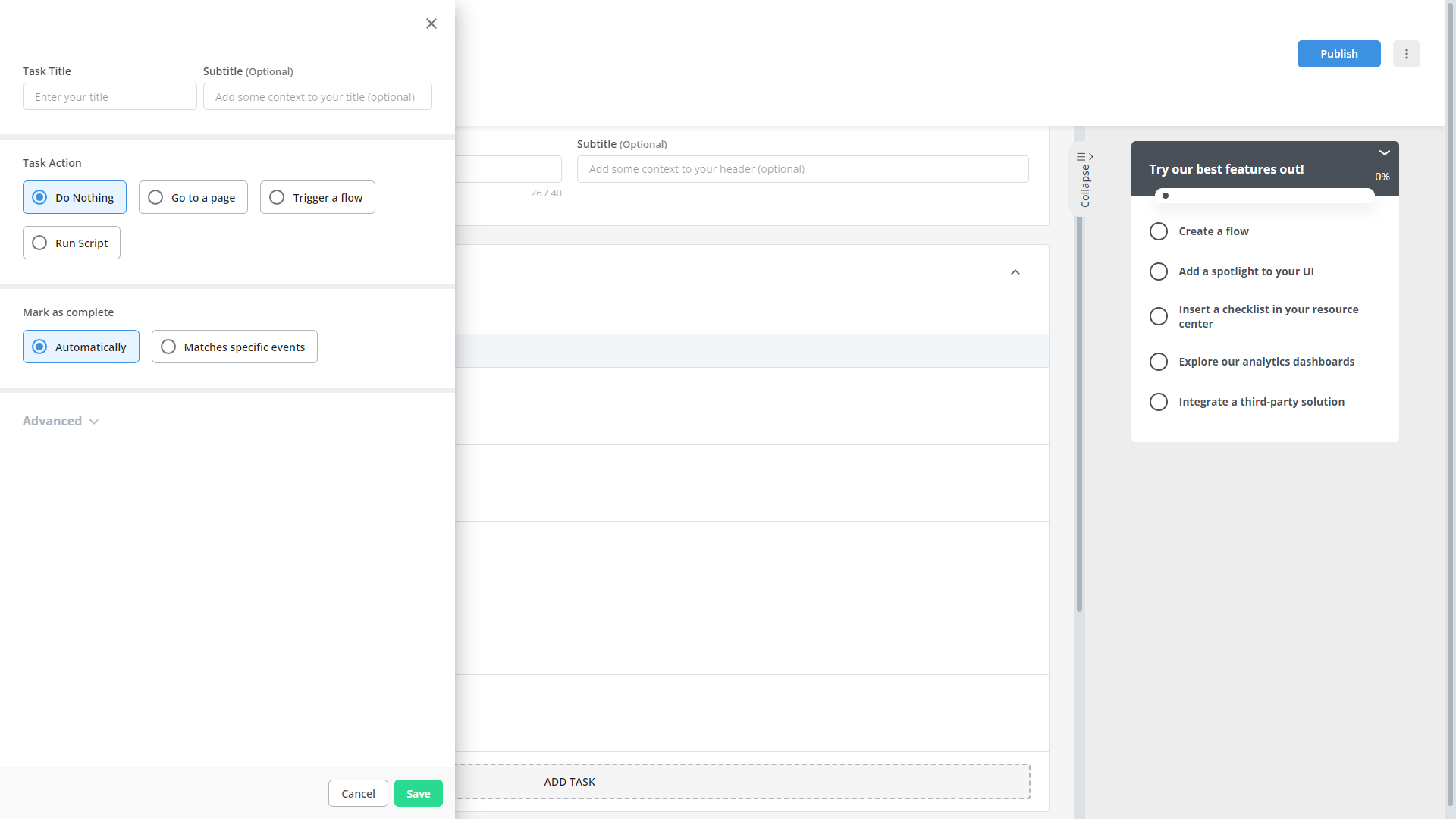
Userpilot’s tooltips
Tooltips are the most straightforward way to offer contextual information to users without interrupting their workflows. Userpilot lets you create tooltips as part of your in-app flows, attach standalone tooltips to individual features, and leverage the power of AI to streamline the process.
Here are the ways you can use Userpilot to create tooltips:
- Tooltip flows: Tooltips are one of the UI elements you can utilize when creating in-app flows. You’ll be able to edit the size, placement, and behavior of your tooltip as needed. You could also toggle the option to continue or dismiss the flow if a tooltip’s element can’t be located.
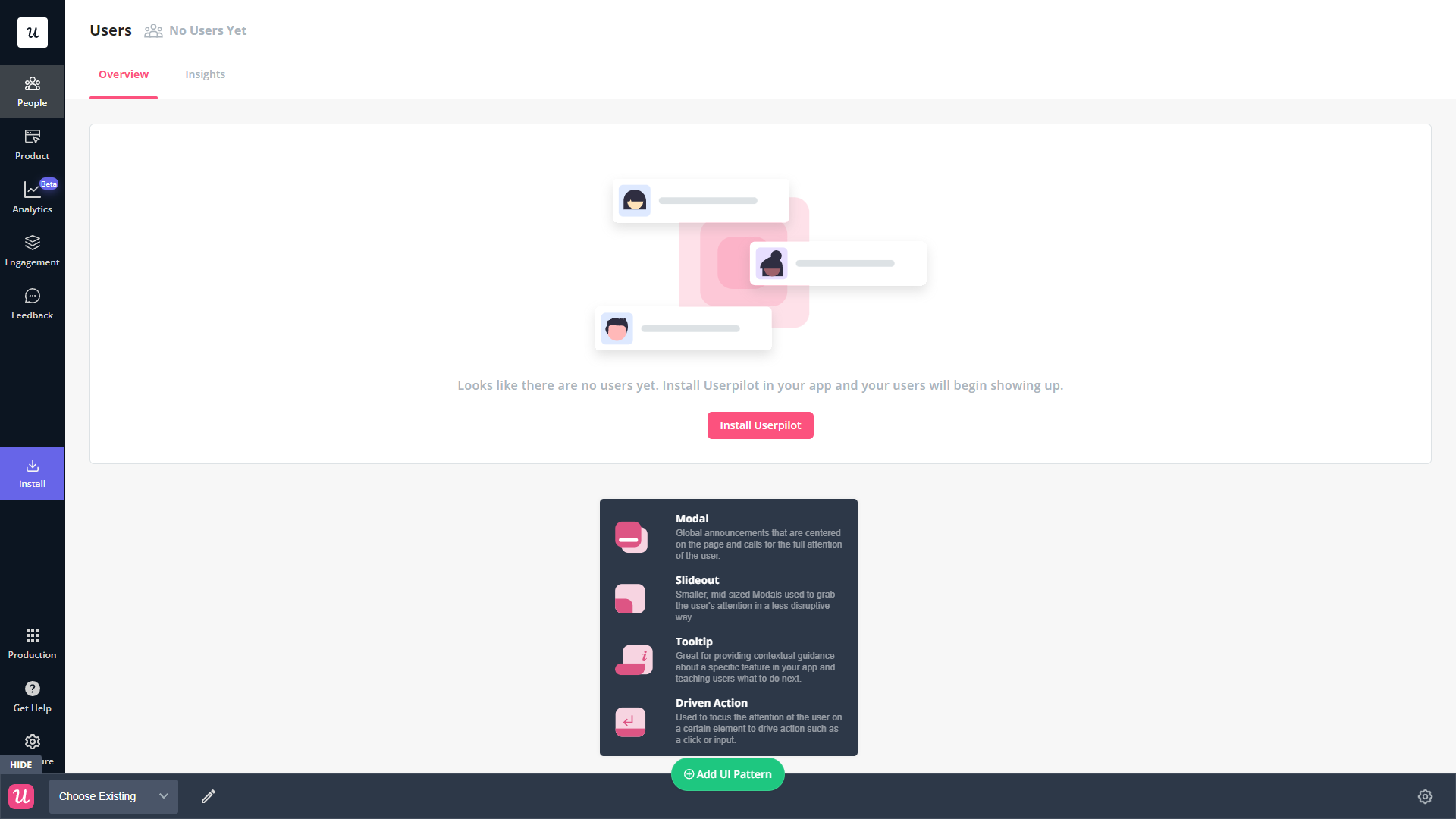
- Native tooltips: Userpilot spotlights let you create native tooltips that expand when users click on an element or hover over a feature. Since these tooltips are attached to the features rather than specific pages, they’ll show up anywhere that the element is present.
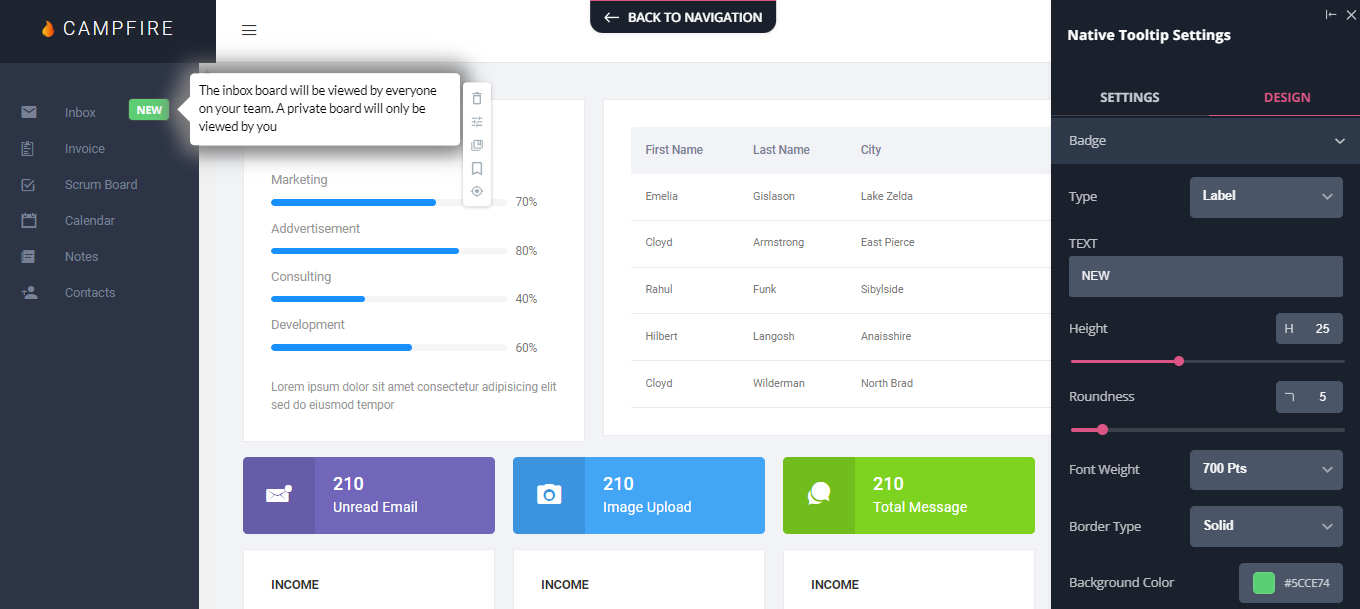
- AI assistance: Userpilot’s AI-powered capabilities help you create better tooltips in less time. You could use the writing assistant to create, shorten, or extend the content of tooltips and leverage automated localization to translate your flow’s tooltips to any of the 32 languages available.
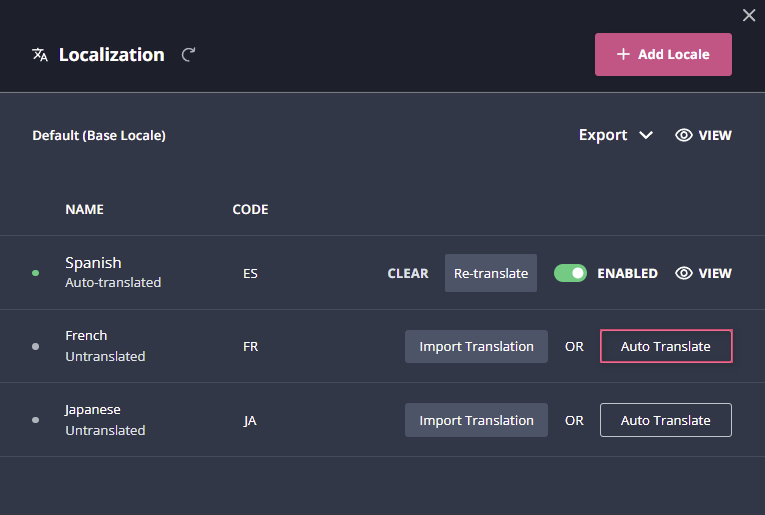
Userpilot’s feature tags
Tracking feature adoption is essential to identify under-utilized features and push users toward discovering them. Userpilot lets you tag features without writing any code, track adoption through engagement analytics, and visualize feature usage with heatmaps.
Here’s how you can use Userpilot to conduct feature audits and drive feature adoption:
- No-code tagging: Userpilot’s no-code feature tagger lets you add tags through the Chrome extension’s visual builder. You’ll also be able to select whether the tag should track clicks, hovers, or text inputs from users to get contextual data that reflects actual feature usage.
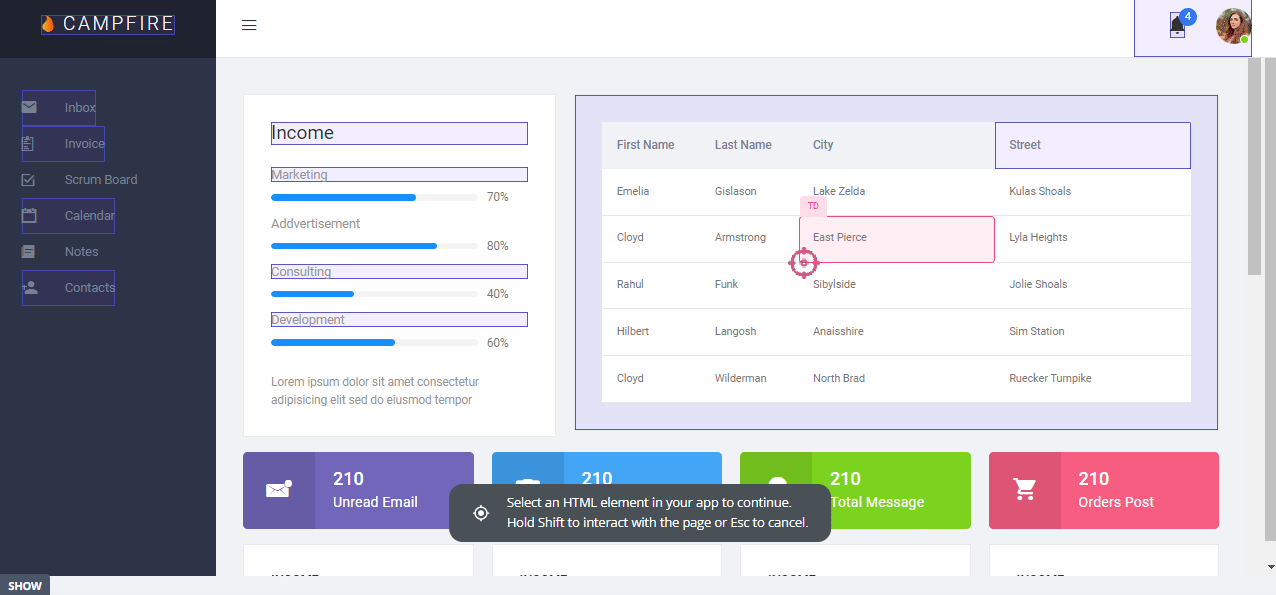
- Feature tags: The advanced feature analytics of Userpilot lets you track feature performance trends, see the top 20 features across your user base, and see granular data for individual features. You’ll also be able to filter your data by segment, company, or time period.
- Usage heatmaps: Userpilot heatmaps show you the features/elements with the most interactions. Heatmaps can be generated on the Features & Events dashboard by clicking on a tagged feature, editing it in the builder, and then clicking the heatmap icon on the bottom toolbar.
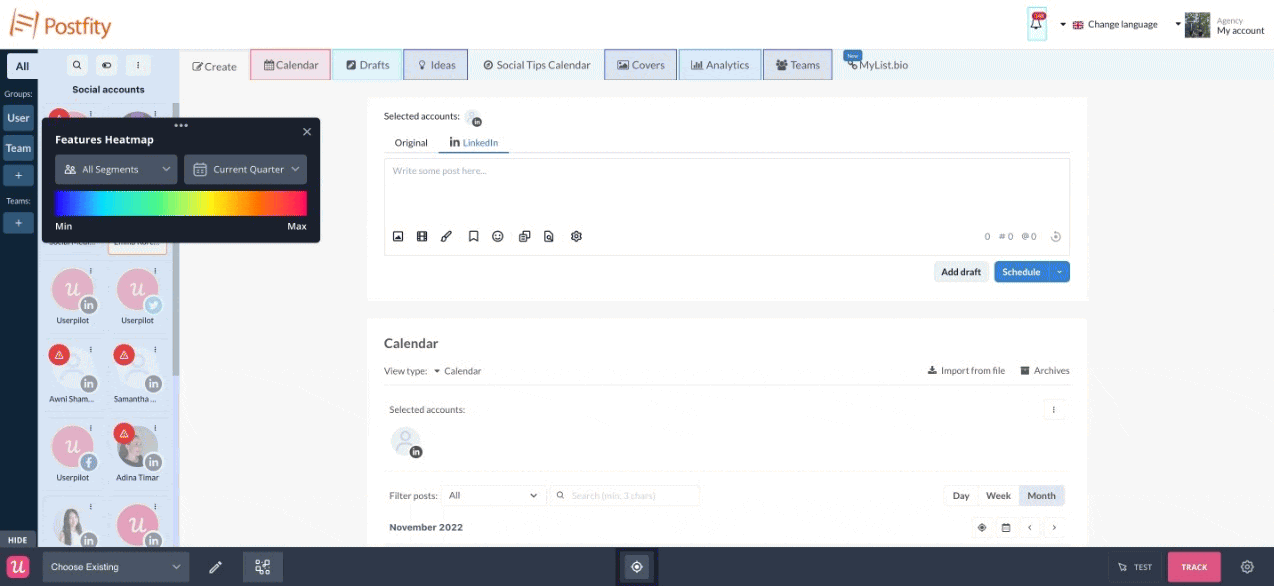
Userpilot’s interactive walkthroughs
Interactive walkthroughs are better than linear product tours because they let new users learn by doing instead of dumping a ton of information on them all at once. Userpilot’s no-code features let you build advanced interactive walkthroughs and create personalized flows for each segment.
Here are the Userpilot features you can use to create interactive walkthroughs:
- No-code builder: Installing the Userpilot Chrome extension makes it possible to build interactive walkthroughs with zero coding needed. You’ll be able to use every UI pattern — such as modals, slideouts, tooltips, and driven actions — regardless of which plan you’re on.
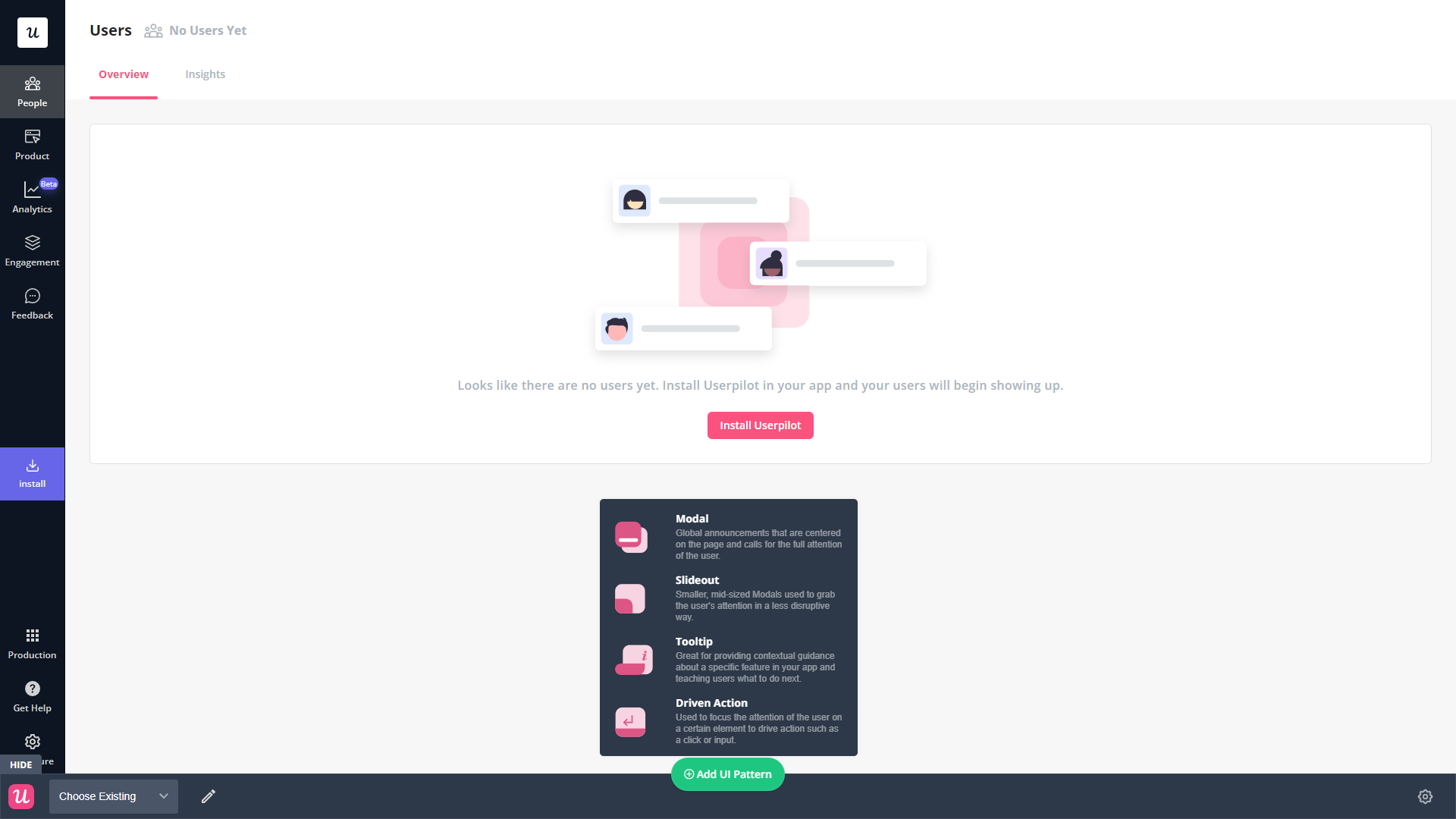
- Welcome surveys: Userpilot lets you create welcome screens that survey users on what their primary use cases, roles, needs, etc., are. You can create different walkthroughs depending on their responses to ensure that there’s a personalized experience for all.
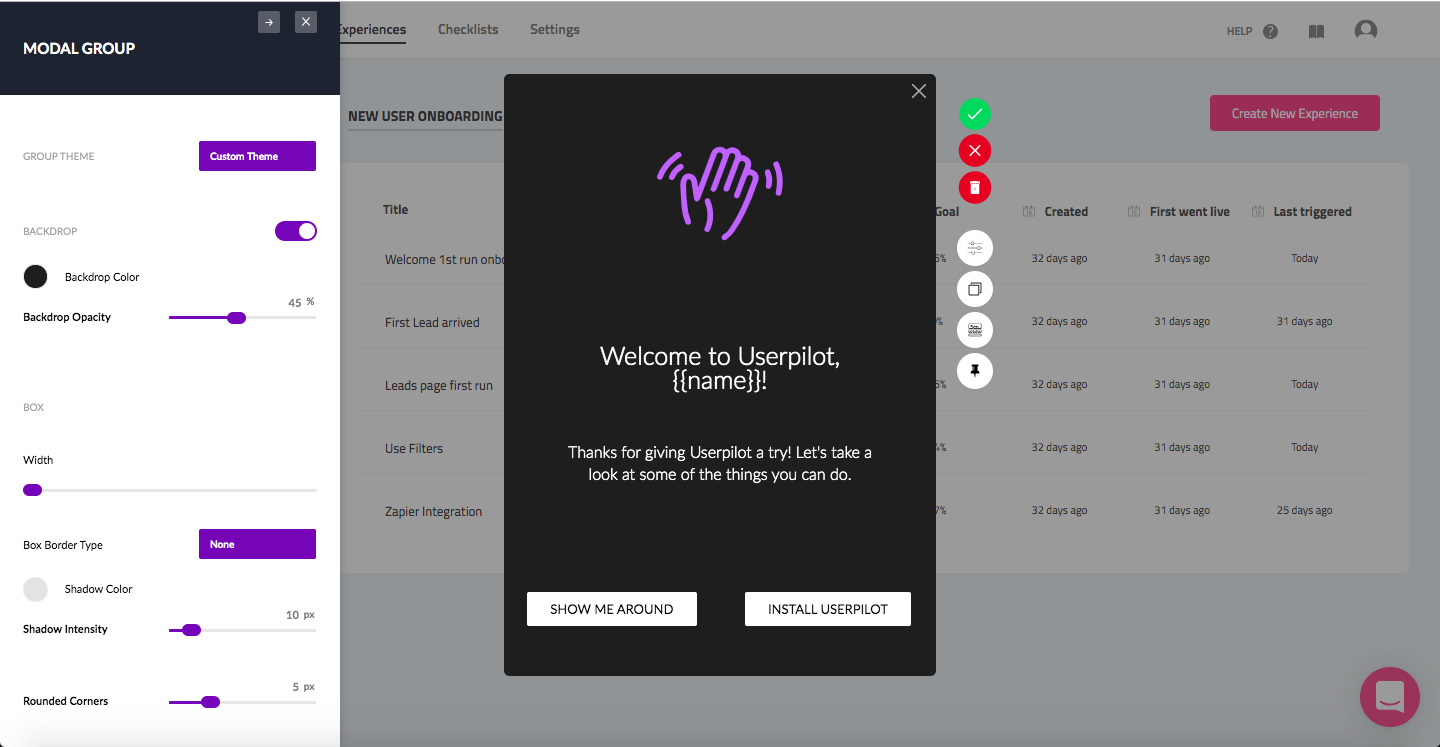
- Audience settings: The audience settings on Userpilot flows help you trigger or hide walkthroughs from specific users and segments. This makes it possible to create interactive walkthroughs that target a particular segment or trigger a flow when certain conditions are met.
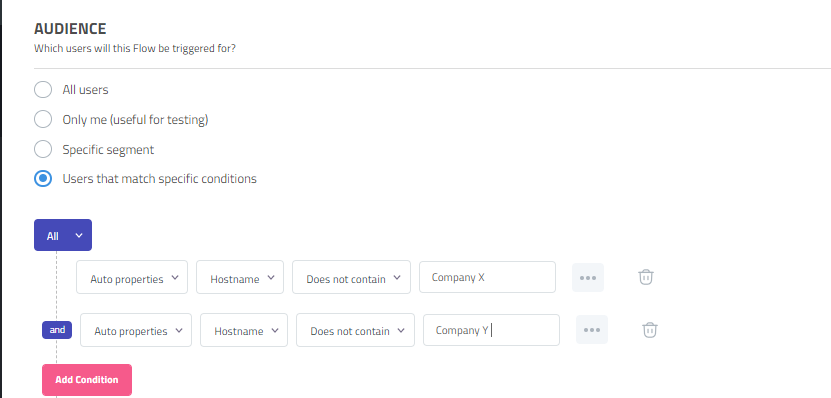
Userpilot’s in-app announcements
Userpilot offers multiple options for broadcasting your announcements to users, such as modals and slideouts as part of a flow or standalone banners for less urgent in-app messages.
Here are the Userpilot UI patterns you can use for your in-app announcements:
- Modals: Userpilot has modal templates for specific use cases such as announcements, but you can also create a new design from scratch. You’ll be able to enhance your modals with emojis, images, and videos to make announcements as engaging as possible for your users.

- Banners: This UI pattern (which you can create with Userpilot spotlights) helps you announce new features, updates, or downtime without taking up the entire screen. You can also add blocks to your banners to insert emojis, media, input forms, or custom JavaScript functions.
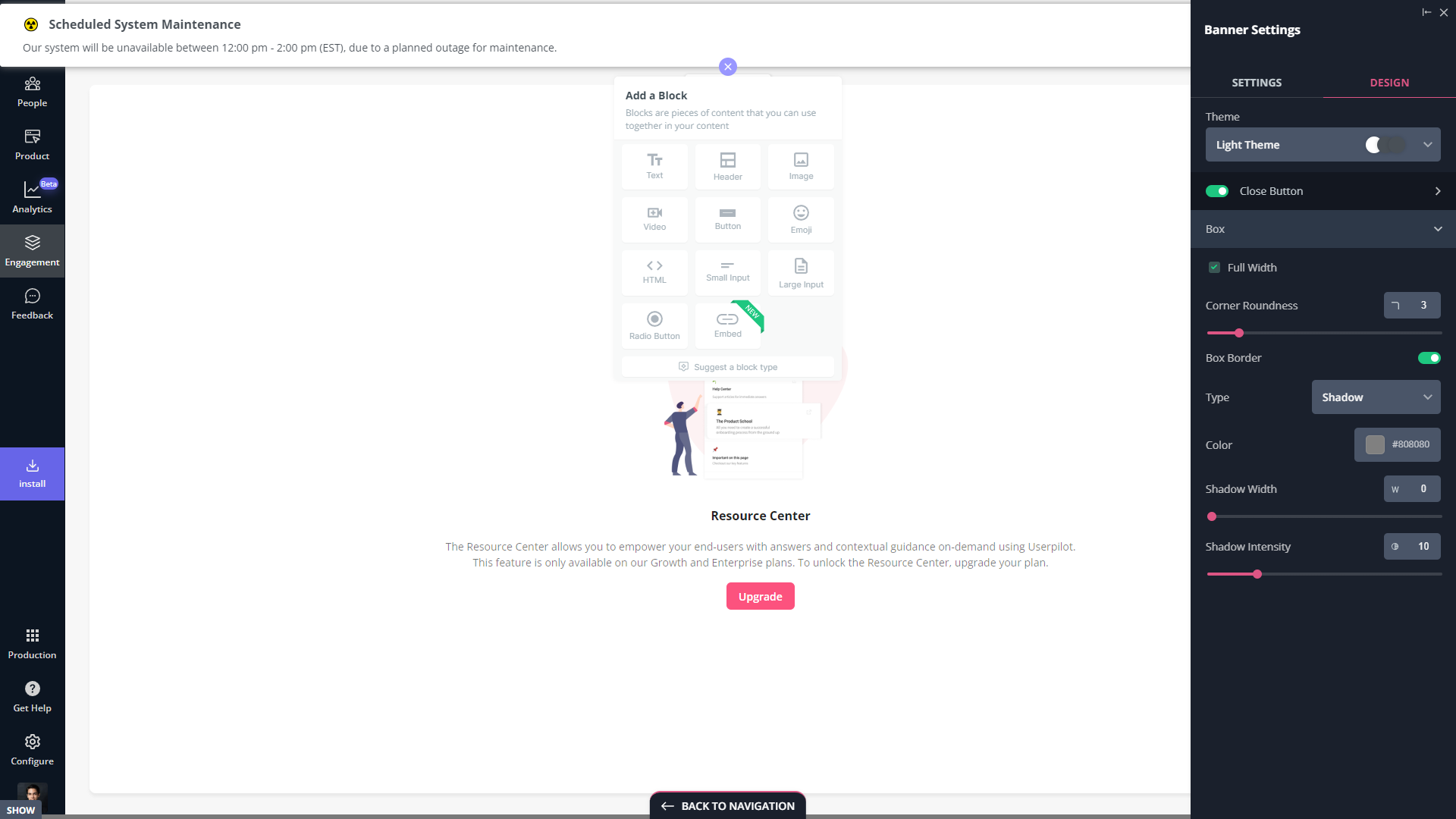
- Slideouts: If you want your announcements to be less intrusive than modals but more obvious than banners, then you can add slideouts to your flows. Userpilot lets you add progressive slideouts, two-button slideouts, and slideouts that trigger a full-on welcome tour.
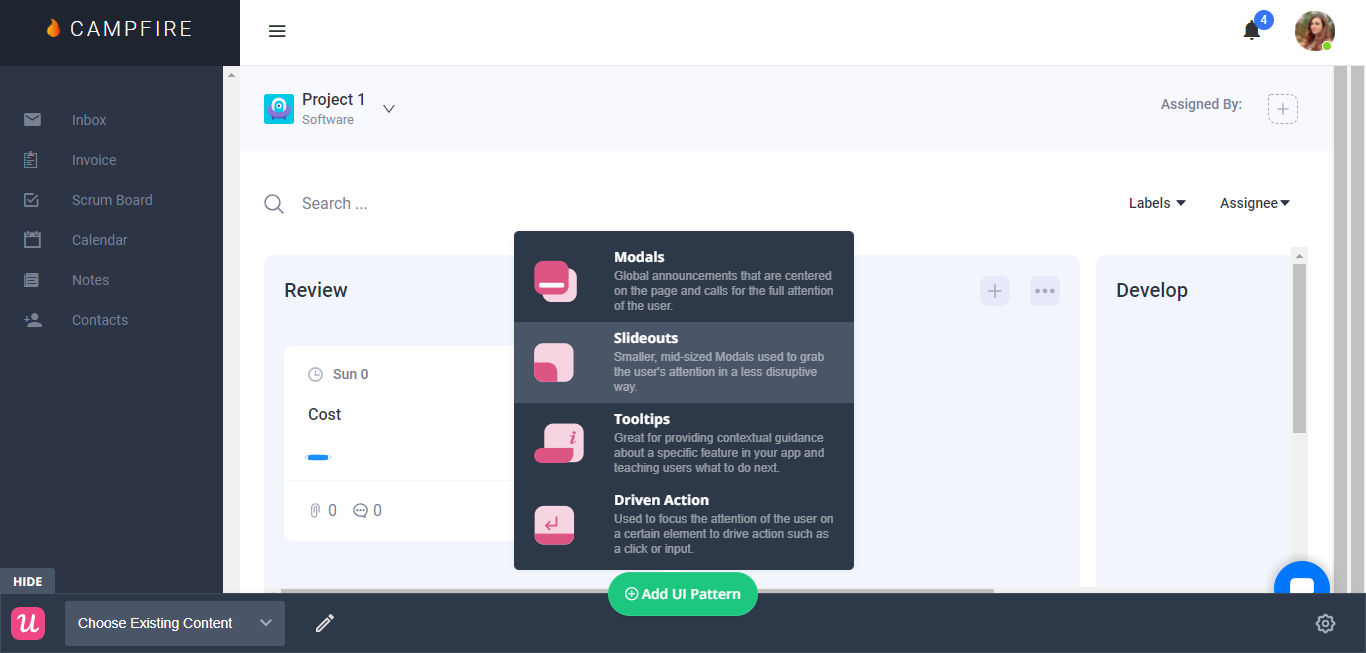
What are the pros and cons of Userpilot?
Userpilot pros
As a full-suite digital adoption platform, Userpilot has all the features you need to onboard users, track analytics, and gather feedback from customers without writing a single line of code. Here are a few pros of using Userpilot as your product growth solution:
- No-code builder: Userpilot’s Chrome extension lets you build flows, add UI elements, and tag features without writing a single line of code.
- UI patterns: There are plenty of UI patterns to choose from when using Userpilot, such as hotspots, tooltips, banners, slideouts, modals, and more!
- Startup-friendly: Userpilot’s entry-level plan gives you access to all available UI patterns so you can hit the ground running.
- Walkthroughs and flows: Build engaging interactive walkthroughs and personalized onboarding flows that target specific segments of your user base.
- Self-service support: Build an in-app resource center to help users solve problems, customize its appearance to align it with your brand, and insert various types of content (videos, flows, or chatbots) to keep your customers satisfied.
- A/B testing: Userpilot’s built-in A/B testing capabilities will help you split-test flows, iterate on the best-performing variants, and continually optimize based on user behavior.
- Feedback collection: Userpilot has built-in NPS surveys with its own unified analytics dashboard and response tagging to help you retarget users. There are other survey types to choose from and you can even create your own custom survey.
- Survey templates: There are 14 survey templates to choose from so you can gather feedback on specific features or run customer satisfaction benchmarking surveys like CSAT and CES.
- Advanced analytics: Userpilot lets you analyze product usage data, monitor engagement on all in-app flows, and use the data to create user segments that are based on behaviors instead of demographics.
- Event tracking: Userpilot’s no-code event tracking lets you tag UI interactions (hovers, clicks, or form fills) and group them into a custom event that reflects feature usage.
- Third-party integrations: Userpilot has built-in integrations with tools like Amplitude, Mixpanel, Kissmetrics, Segment, Heap, HubSpot, Intercom, Google Analytics, and Google Tag Manager so you can share data between all the solutions in your tech stack.
Userpilot’s cons
Of course, no tool is perfect and there are a few cons to consider before choosing Userpilot as your user onboarding or product growth solution:
- Employee onboarding: Currently, Userpilot only supports in-app customer onboarding.
- Mobile apps: Userpilot doesn’t have any mobile compatibility which could make it difficult for developers with cross-platform applications to create a consistent user experience for both versions of their product.
- Freemium plan: There’s no freemium Userpilot plan so those bootstrapping their startup and need sub-$100 solutions should consider more affordable onboarding platforms like UserGuiding or Product Fruits.
What do users say about Userpilot?
Most users laud Userpilot for its versatile feature set, ease of use, and responsive support team:
I recently had the pleasure of using Userpilot, and I must say it exceeded all my expectations. As a product manager, I’m always on the lookout for tools that can enhance user onboarding and improve overall user experience. Userpilot not only delivered on these fronts but also went above and beyond with its impressive new features, unparalleled ease of use, and truly exceptional customer support.
What truly sets Userpilot apart is its outstanding customer support. Throughout my journey with Userpilot, the support team has been responsive, knowledgeable, and genuinely dedicated to helping me succeed. Whenever I had a question or encountered an issue, their support team was always there to assist promptly, going above and beyond to ensure my concerns were addressed effectively.

Source: G2.
Of course, other users are also kind enough to share constructive criticism regarding specific features like event tracking filters:
“The filtration while analyzing specific events is a little confusing. Understanding of custom properties and data management configuration could have been more organised.”

Source: G2.
Userpilot’s pricing
Userpilot’s transparent pricing ranges from $249/month on the entry-level end to an Enterprise tier for larger companies.
Furthermore, Userpilot’s entry-level plan includes access to all UI patterns and should include everything that most mid-market SaaS businesses need to get started.

Userpilot has three paid plans to choose from:
- Starter: The entry-level Starter plan starts at $249/month and includes features like segmentation, product analytics, reporting, user engagement, user feedback, and customization.
- Growth: The Growth plan starts at $499/month and includes features like resource centers, advanced event-based triggers, unlimited feature tagging, AI-powered content localization, EU hosting options, and a dedicated customer success manager.
- Enterprise: The Enterprise plan uses custom pricing and includes all the features from Starter + Growth plus custom roles/permissions, access to premium integrations, priority support, custom contract, SLA, SAML SSO, activity logs, security audit and compliance (SOC 2/GDPR).
Conclusion
There you have it.
It should be easier now to make an informed decision whether Stonly is your go-to option for Digital adoption. Ultimately, the best choice will depend on your product and current needs.
If you’re looking for a better alternative to Stonly for Digital adoption, book a Userpilot demo today to experience firsthand how it can enhance your user experience and drive product growth!
![]()
Looking for a Better Alternative for Digital Adoption? Try Userpilot


